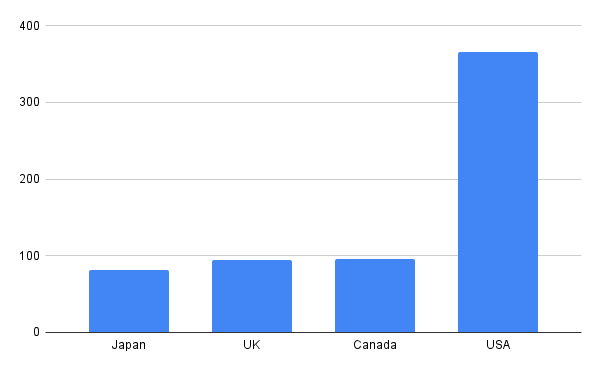By T.A. Spiro-Costello
Introduction
Working on the Cultural Analytics Certificate program exposed me to a lot of the best work in digital humanities scholarship. Two fields that jumped out at me were digital mapping and webscraping. For my cultural analytics practicum completion project, I applied these interests to pose questions about the national origins of videogames on popular consoles, with a focus on the original Xbox.
As an American gamer it always struck me as odd that I grew up on American (if not broadly Western) TV, music, film, (etc.), but my most compelling console videogame experiences occurred while playing games made by Japanese companies.
It also struck me that many of the most compelling PC gaming experiences I had were playing games made by Western developers. In order to hone in on a key point in the development of the American videogame industry, I webscraped and analyzed Wikipedia data on the history fo videogames published for the original Xbox, the first American gaming console in almost 20 years.
History of the Xbox
The release of the original Xbox in late 2001 marked the first major videogame console release from an American company since the collapse of Atari in 1983. The ensuing two decades would see console dominance led by Japanese companies Nintendo, Sega, and Sony. American game developers never went away, pivoting to development for Japanese consoles and for the rapidly-growing PC market.
In many ways, the Xbox represented both a console-interpretation of what had happened in the PC space, and what would come to define major changes in the videogames industry going forward. As a Microsoft product, the Xbox carried with it a number of technical features that owed more to the PC than what had been happening on other consoles. The Xbox’s primary Japanese counterparts in the sixth console generation–the Gamecube and Playstation 2–made use of tiny flash-based memory cards, the Xbox had a hard drive of at least 8GB (1,000 times larger than both the largest memory cards Nintendo sold for the Gamecube and the standard Playstation 2 memory cards).
Even more prescient, the Xbox was designed with networks in mind. The Xbox was built to emphasize multiplayer experiences, both through robust local network capabilities (connecting consoles in physical proximity) and through the Xbox Live service which launched in late 2002. The Gamecube and Playstation 2 were not built with online multiplayer considerations. The Xbox combined this networked experience with its hard drive in order to offer downloadable updates/expansions for games and a marketplace for games that could be downloaded in whole.
Such accommodations were becoming common for PC gaming in the 1990s and would become standard across all consoles the following console generation. But at this time, they served to distinguish the Xbox from other consoles of the generation. Microsoft stands tall as the only American company with a major console to its name. The release of the Xbox marked the solidification of the current big three console manufacturers: Nintendo, Sony, and Microsoft.
In this context it becomes critical to ask, where were Xbox video games developed?
Scraping Wikipedia for Developer Location
In order to determine the nation of origin for all companies involved in the library of Xbox games, first a list must be assembled of those games. Fortunately, an accurate list can be found on wikipedia:
https://en.wikipedia.org/wiki/List_of_Xbox_games
There are a number of tools that can be used to extract this data from wikipedia, including a simple copy-paste sequence. Entering the following formula into google sheets provided me with the complete list in proper format within seconds:
=Importhtml(“https://en.wikipedia.org/wiki/List_of_Xbox_games”,”table”,0)
From there, the data needs to be sorted a few times. At present, I’m only looking at the American market, so everything without an American release date goes. From there, it’s a matter of using the UNIQUE function in the developer and publisher column and sorting through the few dozen entries with commas representing the involvement of multiple companies and a list of 444 companies emerges.
With the help of a python script, largely written by Megan, this list can be augmented with “Headquarters” data found on most of these companies’ wikipedia infobox information.
This script will then cleanly output over 250 of these companies in csv form.
From here the challenge is in refining the code to catch more companies, doing the difficult work to track down certain companies (finding out that Cinemaware was based in Burlingame, CA required the consultation of multiple press released), and sorting the data for trends.
Analyzing Trends in the Data
One initial trend was that the Xbox titles were far disproportionately Western. Of the 23 known developer nationalities, only four appeared on more than 8 titles. Of the 717 distinct developer titles attributed in the American Xbox library, American-headquartered companies accounted for more than 51%.
This tells us that there is a prominent American and Western bias to the Xbox library.
Next Steps
Next steps would involve enhancing the nuance of this data. Looking at release progressions over time, comparing Xbox titles released over different regions, and comparing the Xbox to other consoles would be valuable subsequent analyses in building understanding of how the Xbox influenced American videogame development.
